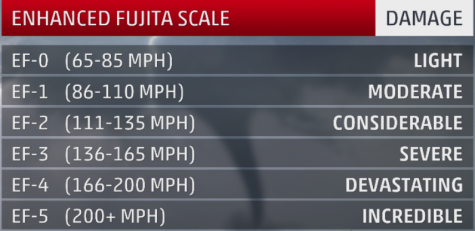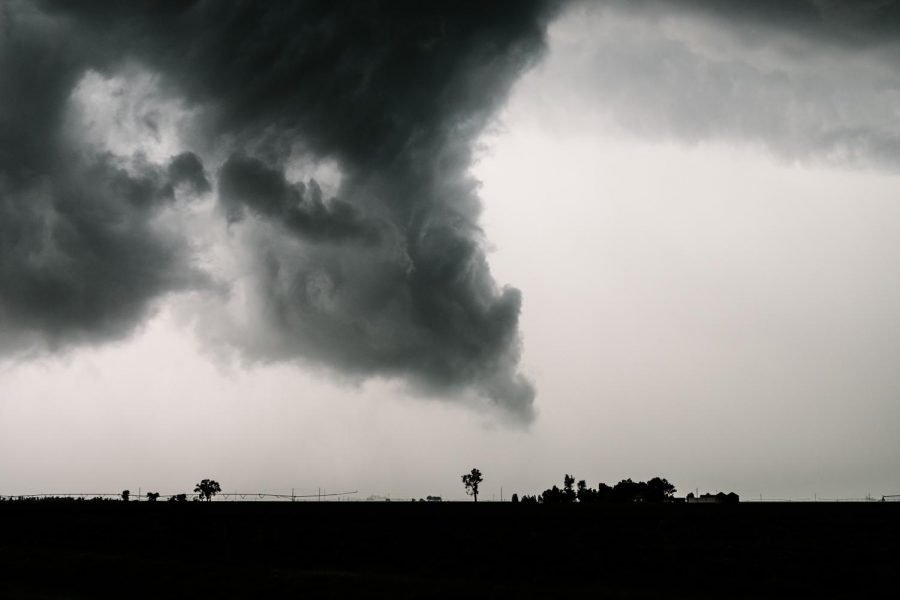Tornado Season is Here!
It almost officially Spring! That means lots of flowers, sunny days, and nice weather. However, that also means rain and different temperatures of air mixing together to make storms. Large and small, storms can start to pop up all over the Midwest. Although thunderstorms can be dangerous, what people really need to start looking out for are tornadoes. According to the National Weather Service, a tornado is, “ a violently rotating column of air touching the ground, usually attached to the base of a thunderstorm.”
 Tornadoes can vary in shape, size, level of destruction, and even color. The main way of classifying these twisters is through the Enhanced Fujita Scale or EF for short.
Tornadoes can vary in shape, size, level of destruction, and even color. The main way of classifying these twisters is through the Enhanced Fujita Scale or EF for short.
 This rating scale sorts the twisting tubes of air by their winds speeds and by the damage they cause. The lowest on the scale is the EF 0, which causes minimal damage. Whereas the highest on the scale, the EF 5 causes mass amounts of damage. The EF 5’s wind speeds can reach over 200 MPH. At this speed, the twister can pick up and throw full-size cars, trucks, hay bales, rooftops, and animals. Houses on an EF 5’s path can and will be completely leveled, while only the barren, grey, concrete base remains.
This rating scale sorts the twisting tubes of air by their winds speeds and by the damage they cause. The lowest on the scale is the EF 0, which causes minimal damage. Whereas the highest on the scale, the EF 5 causes mass amounts of damage. The EF 5’s wind speeds can reach over 200 MPH. At this speed, the twister can pick up and throw full-size cars, trucks, hay bales, rooftops, and animals. Houses on an EF 5’s path can and will be completely leveled, while only the barren, grey, concrete base remains.
As harsh and destructive as these air-wrapped monsters are, they are relatively predictable. While scientists can measure the air moisture, and cloud activity using scientific numbers, how can the average person predict such massive storms? It all starts out with something called a wall cloud. Thee clouds are low lying walls of rain and air that can stretch on more miles. For there to be a ground-touching tornado, there must be some sort of wall cloud to start with. Then, suddenly, the sky begins to change color. The normal cobalt sky shifts into more of a sage color. Normally thunderstorms start pouring rain at this point. Water gushes from the sky along with strikes of lightning and the booming of thunder. If you are close to the point of rotation, you may experience large hailstones falling from the sky, instead of rain. Then, somewhere deep in the greenish sky, the traitorous tube of a tornado starts to form. Swirling around itself and slowly growing. It spins, and spins, and spins, slowly lowering itself to the ground. Once on the ground, true destruction starts to hit. Depending on the tornado size, if the twister comes in contact with any form of car or building, there is a chance that it could have its roof torn up and thrown about, windows broken, and even the pluck the item off the ground as a whole. Once in the air, these objects become flying missiles, just waiting to strike.
 Now, you may be asking, how do I protect myself from this happening? The first action to take is designating a room in your house as a safe place. The best option would be a room that’s underground or in the basement. If you don’t have such a place, find an innermost room. Put as many walls between you and the storm as physically possible. Next, try and secure yourself to a fixed point in that room. Either by lying down in a bathtub, or going into a deep freezer. You want to try and fix yourself in a spot where you can’t be picked up or thrown about. If you own any helmets, put those on as well. They will protect your brain, and help to keep you safe. Then, crouch down on your knees with your head as close to the ground as possible, and your hands covering your neck. This will, in turn, protect your neck from any damage as well. If you are riding in a car, exit the car immediately and find the nearest shelter. Things such as gas stations or local homes with basements are the safest. Gas stations tend to have strong, air tight, walk-in freezers, which can be helpful in the case of a twister. After all the rushing winds, and blaring sirens it will feel calm again. This means the storm has passed, but do not immediately rush out of your safe zone. There could still be flying debris, and pieces of the building that have been broken off. Exit, quickly, but carefully, especially if you begin to smell any gasoline for fire.
Now, you may be asking, how do I protect myself from this happening? The first action to take is designating a room in your house as a safe place. The best option would be a room that’s underground or in the basement. If you don’t have such a place, find an innermost room. Put as many walls between you and the storm as physically possible. Next, try and secure yourself to a fixed point in that room. Either by lying down in a bathtub, or going into a deep freezer. You want to try and fix yourself in a spot where you can’t be picked up or thrown about. If you own any helmets, put those on as well. They will protect your brain, and help to keep you safe. Then, crouch down on your knees with your head as close to the ground as possible, and your hands covering your neck. This will, in turn, protect your neck from any damage as well. If you are riding in a car, exit the car immediately and find the nearest shelter. Things such as gas stations or local homes with basements are the safest. Gas stations tend to have strong, air tight, walk-in freezers, which can be helpful in the case of a twister. After all the rushing winds, and blaring sirens it will feel calm again. This means the storm has passed, but do not immediately rush out of your safe zone. There could still be flying debris, and pieces of the building that have been broken off. Exit, quickly, but carefully, especially if you begin to smell any gasoline for fire.
Besides, the terror surrounding these twisting, twirling, tornadoes, can come the beauty of nature. The disasters can tend to bring people together through public works. It just seems that in a season like this, it is important to highlight the bad effects and safety concerns, so if these natural disasters do occur, the public can be awake, aware, and prepared.

Favorite Quote: "This is chowder. the heaviest of all soups."-Drake and Josh
Favorite Food: Sushi, Scooby Doo Fruit Snacks
Fun Fact: I adore Jeffree Star's makeup line


